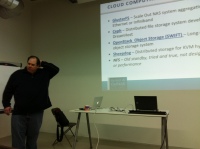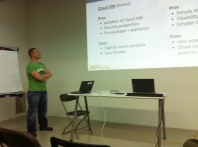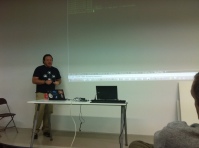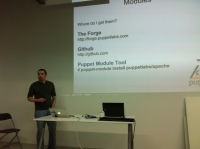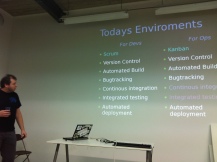For about 6 weeks we’ve been working on finding out if -and how- it’d be possible to create our own cloud. My colleague Pim did a very good job on sorting out all the different software solutions (of course Open Source) and came up with CloudStack as the one we’d definitely to test with. So we did!
We’ve tested both the current stable 2.2 release and the upcoming 3.0 release, which is currently in beta. It took us quite some time to get the right hardware to test with. At first we used Ubuntu as OS but that turned out to be the wrong choice – for now. Ubuntu just isn’t very well supported and CloudStack more or less wants you to use RHEL or one of its free alternatives, like CentOS. We wanted to use Ubuntu at first because we had a lot of Debian experience. Although Google was our friend in helping sorting out differences between Debian-style and RedHat-style (for example in the networking setup). Looking back, moving to CentOS was no problem at all. We even have Kickstart running to be able to do quick unattended installs for the compute nodes. Cool! By the way, this is about the OS on the Compute nodes and Management-server. VM’s can of course be of any kind. In our case they definitely will run Debian.
CloudStack 2.2 works great now, but since we wanted so use some features of 3.0 we decided to give the 3.0 beta’s a go. The main feature 3.0 has, that 2.2 hasn’t, was the ability to move a VM from cluster to cluster (powered down, that is). Also networking has improved in 3.0. Another bonus is the gorgeous UI.
Our biggest hurdle was basically to understand how networking in CloudStack was meant to work. At the time we were testing beta1, the manuals were not complete yet so this proved to be a challenge at times… And – to be honest – we’d also some expectations of how we thought it’d work, that later on proved to be wrong. So we spend quite some time in playing with CloudStack, finding out how exactly it works, debug whenever something went wrong, etc. We listed the questions we had and in many occasions the CloudStack community was of great help. The good thing was that of all the the things we didn’t understand of that didn’t work, we were able to find a resolution to. Either we just had configured something wrong, or we found a bug (which was ok for a beta). It all looks very promising!
At the moment we’re testing beta3 and it has A LOT of improvements, both in UI, docs and functionality. Great job!
We went to Antwerp to visit “Build an Open Source Cloud Day“. There we learned a lot, and were able to talk to some experts on the subject. This helped us, back at the office, to start from scratch and setup CloudStack the right way (for us). Now we could really start experimenting! We’ve both setup a Basic and a Advanced zone to see what suites us most.
We’ve some performance testing to do, and make a decision about the storage we’ll be using. More about that in a later post.
Currently we’re finalizing designing our cloud and we’re pretty sure CloudStack will power it! By the end of the month 3.0 GA release will be there and then we’ll be able to build our cloud in production in march / april. Really looking forward to that!
I’ll keep you guys posted 🙂






